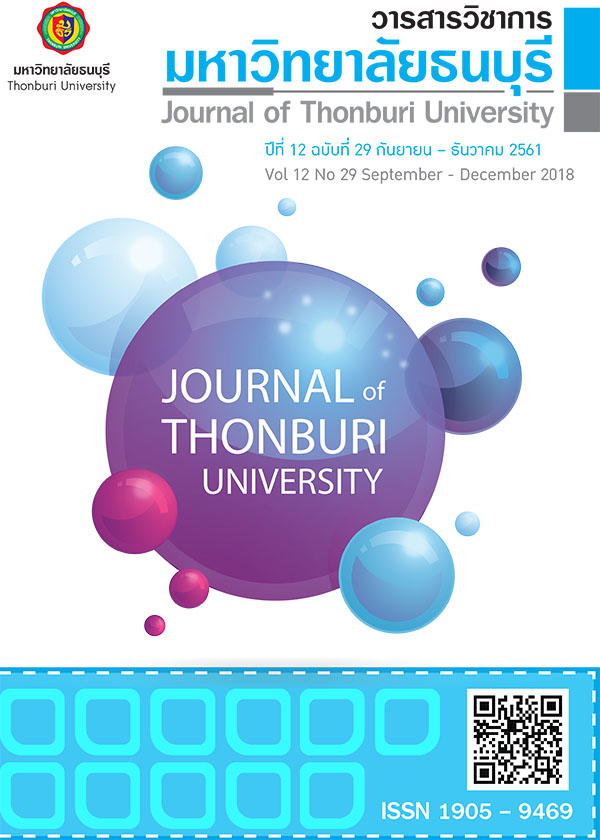CONNECTIVIST DIGITAL LEARNING MODEL VIA CLOUD TECHNOLOGY TO ENHANCE CREATIVE MEDIA INNOVATION CONSTRUCTION
Keywords:
Cloud Technology, Connectivist, Digital Learning, Media Innovation ConstructionAbstract
Abstract
This research aimed to (1) develop the connectivist digital learning model via cloud technology to enhance creative media innovation construction and (2) evaluate the Learning model. Research Methodologies were to (1) studied documents and related research, (2) designed the Learning Model, (3) presented the Learning Model and checked by advisors, (4) created the assessment for suitability of the Learning model, (5) evaluated the Learning model by experts and (6) analyzed the suitability of the Learning Model. The sample group is seven experts by purposive sampling, 4 experts in education and 3 experts in information and communication technology. The statistics used in this study were average and standard deviation. The research found that the synthesised Learning model is called “PPAC Model”, had 4 elements: first element, Plan, includes (1) Connectivist Digital Learning Environment (CDLE) (2) Media and Content (3) Instructor and Learner and (4) Objective. Second element, Process, includes (1) Orientation (2) Connectivist Digital Learning: (2.1) step of learning (2.2) step of find a knowledge (2.3) step of create creative media (2.4) step of discover a problems (2.5) step of find solution to solve problems and (2.6) step of discover solving problems and (3) Assessment. Third Element, Achievement, and Forth element Creative Media Innovation. The suitability evaluated of the PPAC model from the 7 experts, at the highest level (Mean = 4.70, S.D. = 0.63)
Keywords: Cloud Technology, Connectivist, Digital Learning, Media Innovation Construction
References
กระทรวงศึกษาธิการ. สำนักงานคณะกรรมการการศึกษาขั้นพื้นฐาน. (2553). การเรียนรู้เทคโนโลยีโรงเรียนมาตรฐานสากล. กรุงเทพฯ: ชุมนุมสหกรณ์การเกษตรแห่งประเทศไทย.
กันตภณ พริ้วไธสง (2559). การเปรียบเทียบผลสัมฤทธิ์ทางการเรียนของนักศึกษาปริญญาตรี สาขาวิชาวิศวกรรมเมคคาทรอนิกส์ ผ่านบทเรียนอิเล็กทรอนิกส์ออนไลน์ ในรายวิชาฟัซซีลอจิก. วารสารวิชาการมหาวิทยาลัยธนบุรี. 10(22): 22.
เกรียงศักดิ์ เจริญวงศ์ศักดิ์. (2545). การคิดเชิงสร้างสรรค์. กรุงเทพฯ: ซัคเซสมีเดีย.
เกียรติอนันต์ ล้วนแก้ว. (2559). เมื่อ Thailand 4.0 ถูกขับเคลื่อนด้วย Education 2.0. สานปัญญา จังหวัดปฏิรูปการเรียนรู้. 2(26): 1-4.
ทวีป อภิสิทธิ์. (2559). กิจกรรมส่งเสริมความคิดสร้างสรรค์สำหรับเด็กและเยาวชน. กรุงเทพฯ: จุฬาลงกรณ์มหาวิทยาลัย.
นคร เสรีรักษ์;และ ภรณี ดีราษฎร์วิเศษ. (2555). วิจัยไม่ใช่เรื่องยาก. กรุงเทพฯ: สำนักพิมพ์มหาวิทยาลัยธรรมศาสตร์.
บุปผชาติ ทัฬหิกรณ์. (2552). การประยุกต์ใช้เทคโนโลยีสารสนเทศในการเรียนการสอน. พิมพ์ครั้งที่ 2. กรุงเทพฯ: โครงการเทคโนโลยีสารสนเทศตามพระราชดำริ สมเด็จพระเทพรัตนราชสุดาฯ สยามบรมราชกุมารี.
วรปภา อารีราษฎร์. (2555). แอพพลิเคชั่น (Application) คืออะไร. สืบค้นเมื่อ 6 กุมภาพันธ์ 2560, จาก www.itrmu. net/it/indexphp /2012-06-26-03-33-40/93-tablet1
ศรีสุรางค์ ทีนะกุล. (2542). การคิดและการตัดสินใจ. กรุงเทพฯ: เธิร์ดเวฟ เอ็ดดูเคชั่น.
สำนักงานคณะกรรมการการศึกษาแห่งชาติ. (2540). ทฤษฎีการเรียนรู้เพื่อพัฒนากระบวนการคิด ต้นแบบการเรียนรู้ทางด้านหลักทฤษฎีและแนวปฏิบัติ. กรุงเทพฯ: สำนักงานคณะกรรมการการศึกษาแห่งชาติ.
สุวิทย์ มูลคำ. (2547). กลยุทธ์การสอนคิดสร้างสรรค์. กรุงเทพฯ: ภาพพิมพ์.
อภิรักษ์ ปนาทกูล. (2556). Design Mobile App. กรุงเทพฯ: ทรูไลฟ์.
Christensson, Per. (2008). Application Definition. Retrieved 2017, Feb 6, from techterms.com
Kongrugsa, Nawin, Nilsook, Prachyanun and Wannapiroon, Panita. (2016). Designing a Knowledge Review, Based on Connectivism of Cloud Computing for Developing Critical Thinking. International Journal of Information and Education Technology. IJIET 2016, 6(6): 492-495.
Margaret, Rouse. (2007). Application. Retrieved February 6, 2017, from searchsoftware quality.techtarget. com/definition/application
Rongxia, Zhuang and et al. (2016). The framework of digital learning capacity for digital natives. International Conference on Advanced Learning Technologies, 386-390.
Sitti, Snit, Sopeerak, Saroch and Sompong, Narong. (2013). Development of Instructional Model Based on Connectivism Learning Theory to Enhance Problem-solving Skill in ICT for Daily Life of Higher Education Students. Procedia - Social and Behavioral Sciences 103 (2013) 315 – 322.
Translated Thai References
Abhisit, Thaweep. (2016). Activities Enhancing Creative Thinking for Children and Youth. 1st Edition. Bangkok: Chulalongkorn. (in Thai)
Arirad, Woraprapa. (2012). Definition of Application. Retrived 6 June 2017, from www.itrmu.net/ it/index.php /2012-06-26-03-33-40/93-tablet1 (in Thai)
Chareonwongsak, Kriengsak. (2002). Creative Thinking. Bangkok: Success Media. (in Thai)
Luankaew, Keitanan. (2016). When Thailand 4.0 is driven by Education 2.0. Sanpanya Provincial Learning Reform. 2(26): 1-4. (in Thai)
Ministry of Education. Office of the Basic Education Commission. (2010). Learning International School Technology. Bangkok: Agricultural Cooperative Federation of Thailand. (in Thai)
Ministry of Information and Communication Technology. (2011). Information and Communication Technology Policy Framework of Thailand ICT 2020. 1st Edition. Bangkok: Government Complex. (in Thai)
Moonkhum, Suwit. (2004). Creative teaching strategies. Bangkok: Parbpim. (in Thai)
National Education Commission. (1997). Theories of learning to develop thought processes. Principles of learning theories, theories and practices. Bangkok: National Education Commission. (in Thai)
Panatakul, Apirak. (2013). Design Mobile App. Bangkok: Truelife. (in Thai)
Priewthaisong, Kantapon. (2016). Comparison of Learning Achievement of Undergraduate Mechatronics Engineering Students by Learning Online E-Learning Course on Fuzzy Logic. Thonburi University. 10(22): 22. (in Thai)
Saereerak, Nakorn;& Deeradwised, Poranee. (2012). Research is not difficult. Bangkok: Thammasat University Press. (in Thai)
Teenakul, Sreesurang. (1999). Thinking and Decision. Bangkok: Third wave education. (in Thai)
Tulhikorn, Buppachat. (2009). The application of information technology in teaching. 2nded. Bangkok: Agricultural Cooperatives, Thai National Assembly Publishing. (in Thai)







